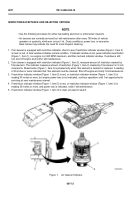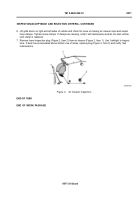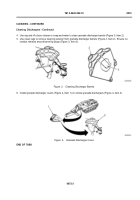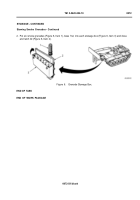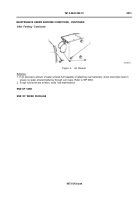TM-5-5420-202-10 - Page 464 of 535
0073
TM 5-5420-202-10
Extreme Cold Weather
Typical Problems in Extreme Cold Weather: Maintenance of mechanical equipment in extreme cold conditions
is exceptionally diff cult in the f eld. Even shop maintenance cannot be completed with normal speed because
equipment must warm up before satisfactory repairs can be made. In the f eld, maintenance is performed under
themos
td
i
ff cult conditions. Bare hands will stick to cold metal. Engine oils, except subzero grades, will not pour
at temperatures below -40°F (-4.5°C). Ordinary greases become hard at extremely cold temperatures. These
diff culties increase the time required to perform maintenance. At temperatures below -40°F (-4.5°C), procedures
requ
ireupto f ve times the normal amount of time. The time required to warm a vehicle so it will start and be
operable at temperatures as low as -50°F (-10°C) may approach 2 hours. Complete winterization, diligent
maintenance, and well-trained crews are the key to eff cient operation of vehicles in extreme cold weather.
Batteries: Extreme cold causes batteries to freeze and prevents them from furnishing suff cient current. See
FM 9-207 for methods of protecting batteries from cold, and maintenance of batteries in cold weather.
Tracks and Suspension: If possible, clean mud, snow, and ice from tracks and suspension after stopping. See
FM 9-207 for more detailed information about maintenance of tracks and suspension, and effects of cold weather
on tracks and suspension.
Canvas Covers: Canvas covers present diff culties in conforming to their intended use due to apparent shrinkage.
Shrinkage is usually a result of wrinkles that are extremely diff cult to smooth out at subzero temperatures.
Whenever possible, warm and unfold canvas in heated enclosures. Clean all snow, mud, and ice from vehicle
before covering. Keep ends of canvas off ground to prevent entrance of snow into engine compartment. Snow will
melt and later freeze, which may prevent linkage operation.
Metal Parts: Metal parts become brittle at subzero temperatures and cannot withstand shock loads as well as at
normal temperatures. Frequently inspect metal parts and components for cracks and breakage.
Plastic and Rubber Parts: Handle any parts made of plastic or rubber carefully. Plastic and rubber parts become
brittle in cold weather and may break due to vibration or handling. To prevent insulation from cracking and
causing short circuits, warm rubber or plastic insulated cables before bending, and ensure that all cables are
properly installed.
Fuel and Lubricants: See FM 9-207 for instructions on storage, handling, and use of fuels and lubricants in
cold weather.
Extreme Hot Weather
Typical Problems in Extreme Hot Weather: Extreme heat causes water, lubricants, and fuels to expand and
possibly overf ow their containers. Perspiration from hands contains acids and salts, which cause corrosion of
unprotected metal parts when handled. Engines and transmissions have a greater tendency to overheat. Metal
parts can become too hot to handle, and paint can blister. Extreme heat and overexposure in the sun can cause
rubber and plastic parts to age and crack.
Batteries: Batteries will self-discharge at a greater rate if left standing for long periods of time in high temperatures.
Consider this condition when operating in hot zones. Run vehicle engine periodically to keep batteries charged.
Metal Parts: Remove paint blisters with abrasive paper and spot-paint as required.
Plastic and Rubber Parts: Check plastic and rubber-insulated cables for cracks, which can result in short circuits.
Check all plastic and rubber parts for cracks and aging.
Optical Equipment: Do not expose sighting/optical equipment or optical parts to direct rays of sun.
0073-2
MAINTENANCE UNDER ADVERSE CONDITIONS
Back to Top


